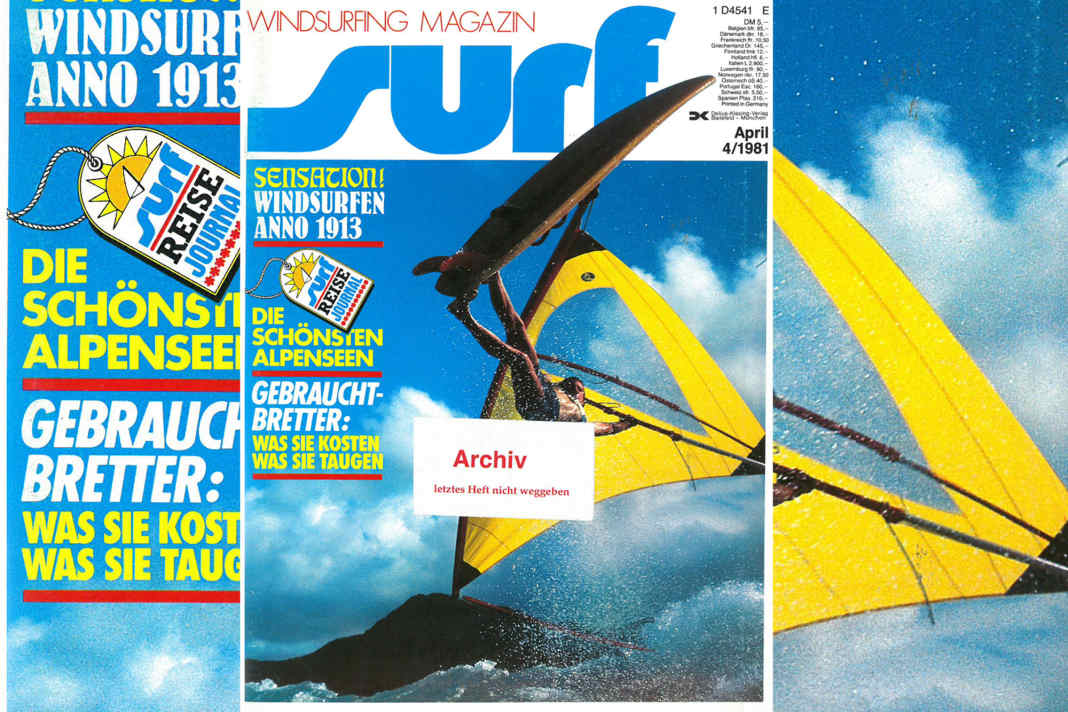





Sensation: Windsurfing 1913!
Jim Drake invented windsurfing! Really? surf dug up a truly adventurous story in 1981: The supposedly first windsurfing attempts by a Frenchman named Martin D'Estreaux existed as early as 1913! A journalist discovered this, along with an extensive photo album documenting the construction and the first attempts to ride the board. The 40 kg wooden board carried a lovingly sewn sail, and the moustachioed rider in the striped swimming costume is somehow reminiscent of surf tester Kutte Prießner. And when you look at the publication date, even the last reader realises that Jim Drake has nothing to worry about: The story is an extremely elaborately produced April Fool's joke!
How up-to-date is the Windglider?
Introduced in 1976, the "German answer to the Windsurfer" was "only" (!) five years old in 1981. surf takes a closer look at Ostermann's "number of units giant" in a report. According to the report, one of the secrets of the Windglider's success was that, at 231 litres, it had more volume than the 191-litre Windsurfer. This meant that it "also got corpulent Germans over the waves", while the smaller Windsurfer undercut the waves. The main criticism of the board, which was considered particularly good in strong winds in the scene, was the poor workmanship and sensitive surface in the early years. In addition, the weights varied between 18 and 24 kilos, and regatta riders could order one of the lighter models in the shop. The fact that the Windglider was chosen as the Olympic board was met with criticism - especially in the windsurfing scene.
Alternative courses
Back in 1981, regattas still meant sailing a course in the shape of the Olympic triangle. Three crosses, two space sheets, one downwind - done. As with sailing: "The race is decided on the cross." However, as the increasingly popular gliders do not tack as well as displacers, new courses are being sought. From the "twisted triangle" to the "buoy slalom" to the "double triangle", there are various - rather complex - suggestions. The downwind slalom that is common today can be recognised in detail, but not yet in its pure form.
And what else?
- New subscribers received a surf wind vane for the masthead as a bonus - a whopping 2.50 metres long
- Seven companies that build boards under the Schweitzer licence were scrutinised by the European Commission during a house search in 1981. The accusation: prices were being kept artificially high through collusion.
- Advertising slogan of a neoprene supplier: "Without a wetsuit from Body Glove, the surfer is just a chill with a sail."
- Due to overproduction and a poor summer in 1980, there are 81 many discontinued models at favourable prices. As a result, the prices for used equipment plummet.
- Thomas Staltmaier surfs 330 kilometres in 24 hours in the Caribbean - world record!
- The Schweitzer patent does not apply in France, which is why the market there is more versatile and faster, as surfing author Wolfgang Windhager marvelled at at the Paris "Salon Nautique"!
- Last part of the surf self-build series: The "Speedmachine" gets its finish - and the readers on the following pages will get instructions on how to ride such a board.
